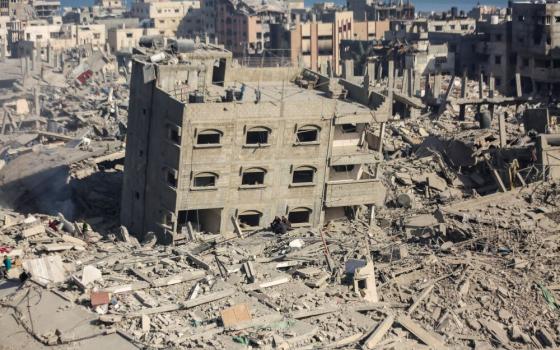
ONGATA RONGAI, KENYA -- In the cool early morning hours of Jan. 14, I was awakened by piercing screams. Again and again, the women screamed.
I did not know it then, but gunmen had broken into the complex of the Evangelizing Sisters of Mary, an African order of Catholic sisters where I was spending the night.
When the men came to her door and demanded money, Sr. Levina Kalikwela grabbed a small, gold-veneered framed picture of the Virgin Mary with the baby Jesus.
“They entered and I held it,” the sister told me the next day, standing in her destroyed bedroom. “I said, ‘God, we’re finished,’ And I just held it lake this.” She grasped the picture in both hands and held it over her head.
The men hit the picture with their knife, breaking it, Kalikwela told me.
“They were asking me,” said Kalikwela, her voice cracking. “And I was telling them I have no money. I have no money.”
That night the gunmen murdered one of the compound guards. While the did not physically harm the sisters, they manhandled three, threatening them at gunpoint and demanding to be taken to the order’s funds. After some sisters raised the alarm with their screams, the robbers eventually fled with a large amount of the convent’s operational funds. Police continue to search for the attackers.
The brutal break-in, while unusual in its severity, highlights the violence that often confronts many religious sisters in Africa as they work in relatively dangerous areas by nature of their missions.
“We are exposed [through] our work with the poor, with the vulnerable,” Sr. Anna Mary Henrietta Nyangoma, the Evangelizing Sisters’ superior general, said the day after the attack. “And maybe in defending the rights of the voiceless, [sisters] automatically get opposition.”
| For for information on the Evangelizing Sisters of Mary, see Christina Lewis's sidebar to this story: African order cultivates place of refuge for locals |
As many as 217 women religious have died violent deaths between 1950 and 2000 in the course of their work in Africa, according to a book by Comboni missioner Fr. Neno Contran, Ambushed: Women Martyrs in Africa.
In interviews I conducted in recent weeks with over a dozen sisters in Sudan, Kenya and South Africa, roughly half said they had been victims of crimes. One sister, a member of the Holy Family Sisters of Bordeaux, a roughly 2,000-person order based in Rome, said she was violently beaten by thieves when she was the manager of a school in South Africa. During her time there she was also carjacked twice, she said. Despite these attacks, she chose to stay in her mission.
An elderly member of the Evangelizing Sisters told me of her time in Turkana, in northwest Kenya, when sisters feared warring bands of “rebels,” who attacked sisters repeatedly. One sister lost an arm.
To be sure, crime is endemic in many parts of Africa. Nairobi is so dangerous, the city has been dubbed “Nai-robbery.” And sisters are not the only members of the church who are attacked. Criminals often also target priests. Contran is also the author of a book on male martyrs, in which he counted 200 priests killed in Africa during the second half of the 20th century.
The sad truth is that in Africa, where the gap between rich and poor looms very wide, virtually any member employed by the church can appear to be relatively wealthy. And even if the thieves understand that members of religious orders have little or no money of their own, criminals see that religious institutions do have money.
Thieves see women religious running schools and hospitals and conclude that they make ripe targets. In the case of the attack on the Evangelizing Sisters’ compound, the robbery came just after the sisters had received and were set to distribute funds to their other communities, according to Nyangoma, the superior general, suggesting that the robbers had inside information.
“Any religious group is looked at as having money,” said Sr. Giang Nguyen, a Maryknoll sister who leads peace-building workshops in Nairobi, along with two other sisters. “I am very worried about violence,” continued Nguyen, who has been robbed. “We do not go out at night.”
The Evangelizing Sisters of Mary congregation was founded in 1975 in Uganda by two Italian missionaries. At that time Ongata Rongai was still a rural area. The town has since become engulfed in Nairobi sprawl. Directly behind the compound lies a slum.
The Evangelizing Sisters comprise roughly 300 sisters spread out across East Africa. The sisters define evangelism as not only “to proclaim the good news of the Lord,” but also to develop the church where it is already implanted by eliminating ignorance and healing the sick, says Nyangoma.
The order’s founders left the congregation land-rich. The walled compound where the attack took place measures a total of 27 acres. It contains two schools, a small maternity hospital, a counseling program that assists hundreds of HIV/AIDS sufferers, an orphanage, a novitiates dorm, and a home for the elderly.
The thieves, however, broke into the convent itself, which is separated from the larger compound by a concrete wall. The single-story structure, which is arranged around a courtyard, houses 30 sisters, along with a shrine to the Virgin Mary and a small chapel, as well as a refectory, a laundry and some offices.
The sisters’ day-to-day life involves daily morning Mass, and then work in one of the convent’s various institutions, or a day of study at a local university. Like most other African women religious, they wear gray, blue or white habits.
In an effort to protect their food supply, much of the sisters’ extra land has been given over to farming and animal husbandry. The sisters grow kale and have dozens of goats, pigs, chickens, rabbits, and cows, which produce enough milk to feed the sisters with some leftover to sell.
Yet despite this large real estate the congregation is cash-poor. Since the passing of the order’s European founders, the congregation has struggled to replace that funding.
“When we were with the whites, the Italians, they sustained the congregation,” said Nyangoma. “We would bother how to manage and retain [the money] that we are using. [But] we would not bother where money comes from, how it comes in.”
She acknowledges that keeping a significant sum of money in the convent was unwise, but points out that it was about to be disbursed. The mother superior says that if the order cannot replace the money that was stolen, they may have to stop paying hospital bills for sick sisters and cancel planned expansion projects.
The gunmen infiltrated the compound by cutting a hole in the fence. The compound’s alarm system malfunctioned. They killed the guard and then sneaked into the convent by forcing open a window.
From there they broke into three sisters’ rooms, including Kalikwela’s, and marched them out at gunpoint, demanding to be led to the superior. Kalikwela had remembered to hide her cell phone in her brassiere and she clasped a small cross. As the women were forced at gunpoint to walk through the compound, Kalikwela pretended to collapse. The gunmen left her. The sister dragged herself along the ground into a side room and called other sisters to raise the alarm.
“Come,” she told them. “They have carried [away] people. You scream. You scream.”
The sisters screamed. The gunmen fired a gun twice, shooting into the air. I heard the shots — they sounded like a cross between a door banging shut and thunder. Pandemonium reigned until the police arrived. By then, the thieves had disappeared.
I remained inside my room, terrified.
The next day, the sisters did not break stride, celebrating their daily morning Mass in their private chapel. The attack appeared to have been a robbery and nothing more.
But later that morning the watchman’s body was discovered. The convent had become a grisly crime scene.
A crowd of sisters, novitiates, employees and visitors gathered around and many stared as policemen dragged the watchman’s body out from behind a bush where his murderers had hidden it, and turned him over, exposing his battered face and stabbed chest. Some onlookers cried.
Over the next few days, the police questioned many sisters as well as their second watchman, who said he did not hear the assault. They instituted a sundown curfew. After about 7 in the evening no one was allowed to leave or enter the compound.
Meanwhile, the neighborhood became a hotbed of criminal activity, with robberies and burglaries each night. Three days after the convent was attacked, police shot two alleged thieves who they believed were part of the gang that assaulted the sisters.
Police are continuing to search for the women’s robbers. The stolen money is considered long gone.
[Christina S.N. Lewis is a freelance writer on assignment in Africa for NCR.]







